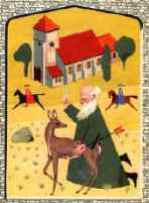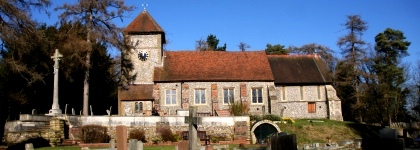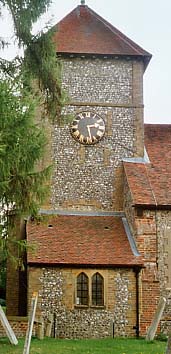


THE WESTERN TOWER
The Western Tower is a somewhat battered structure; the date of original construction cannot be determined with accuracy, but is almost certainly medieval in origin.
| The original tower, as seen in
a drawing dated 1701, was not dissimilar to the present tower at Chelsfield Church
and was constructed of flint with projecting corner buttresses,
and possessed a steeple, probably covered in oak shingles. In 1724, the tower and spire were damaged during a storm, were re-slated in 1728 and were still in existence in 1790, when the artist H. Petrie FSA drew the church (right). |
 |
However, in 1838, luck was to run out for the tower, when it was struck by lightning and severely damaged, requiring it to be extensively rebuilt that same year, with the addition of the clergy vestry constructed against the South wall.
The repairs were carried out by a Mr Blackshaw, mainly in yellow London stock bricks, which were used in the rebuilding of the corner buttresses, for new dressings around blocked-in openings and in the rebuilding of the top of the tower.
The timber steeple was not replaced, and the tower was given a flat roof with a parapet crowned with a stone pinnacle at each corner.
The 1838 rebuilding seems not to have been a total success, for the tower was to suffer continuing problems for the next hundred years. According to the Churchwardens' record book, by 1853 the lead flat roof on the tower was leaking, and the tower and vestry suffered from dry rot all through the 1850s and 1860s. In the 1890s the tower was repaired externally.
It was to suffer one further disaster in January 1949, when it was almost gutted by fire.
 |
|
It remained unrepaired until 1951 when it was restored to its present state by Miss Cunningham, the Church Architect of the day. The tower that is seen today, is ostensibly that rebuilt by Blackshaw in 1838, with one major alteration, that of replacing the flat roof and parapet with the pyramidal roof clad in plain tiles
 |
Internally, little predates the fire of 1949. On
entering the church through the West doors, there is a set
of partly glazed oak-panelled doors installed to commemorate
the Silver Jubilee of George V in 1936. Also within the
ground floor of the tower is the parish's Second World War
memorial to the left of the inner doors. The first floor allows access to both the Gallery in the Nave, and the Belfry above. Set within the Belfry is the Church Clock. This was acquired by a previous Rector, Revd. Aidan Chapman, in the 1950s from the stable block of The Rookery, a large house which once stood on the site of Bromley College of Technology. The Clock was constructed in about 1870 by the makers Barrard and Lund and is of the semi-flat bed form. It strikes the hour on its bell, which was cast in 1766 by John Hudson of London. |